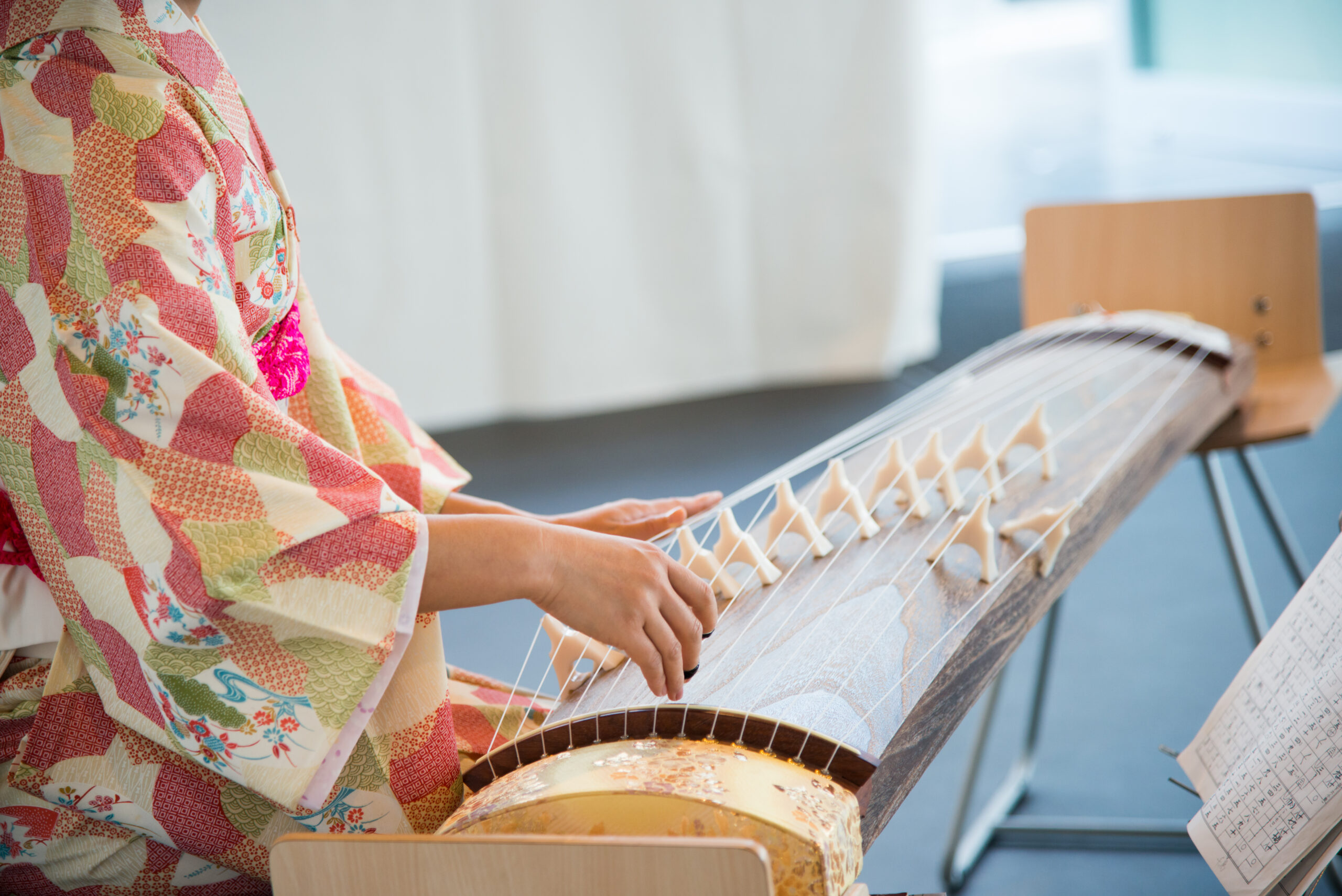In the heart of Japan’s rich cultural tapestry, the koto harp resonates with the soulful echoes of the nation’s ancestral heritage. This traditional string instrument, known for its elongated body and mesmerizing sound, is experiencing a remarkable revival in contemporary society. Once confined to the noble courts of ancient Japan, the koto is now striking a chord with audiences worldwide, transcending borders and generations. This resurgence is not just a testament to the instrument’s enduring allure but also to the dedicated efforts of musicians and artisans who are reimagining its role in the modern world. As we explore the multifaceted journey of the koto, from imperial courts to the digital age, its evolving narrative offers a compelling glimpse into the past, present, and future of Japanese music and culture.
1. Reviving Ancient Echoes: Japan’s Koto Makes a Comeback
The serene strings of the koto harp are echoing louder than ever in Japan, marking a resurgence of interest in the traditional instrument. Once integral to the repertoire of courtly entertainment, the koto had faced a decline as Western music influences grew. However, recent years have witnessed a revival, with both young and old drawn to its melodious charm. Musicians are innovating within the genre, blending ancient tunes with modern sensibilities, thereby attracting a new generation of listeners. Educational programs and community workshops have proliferated, aiming to preserve and pass on the knowledge of koto playing. Social media platforms have also played a pivotal role, allowing virtuosos to share their skills with a global audience, thus breathing new life into this ancient art form.
2. Strings of Nostalgia: The Koto Harp’s Modern Journey
The journey of the koto harp in modern times is a poignant narrative of nostalgia and innovation. As Japan raced towards modernization and global integration, the koto’s presence waned, overshadowed by the allure of contemporary music. Nonetheless, a dedicated cohort of musicians and enthusiasts began weaving the koto’s nostalgic tones into the fabric of modern Japanese music, sparking a gradual renaissance. Today, the instrument is not only a staple in traditional performances but also features in contemporary music festivals, fusion bands, and even film scores. This resurgence has highlighted the koto’s versatility and its potential to convey profound emotional depth, bridging the past with the present.
3. From Imperial Courts to Digital Age: Koto’s Evolution
The evolution of the koto from the imperial courts of Japan to the digital age is a fascinating tale of cultural endurance and adaptability. Historically, the koto was a symbol of aristocratic sophistication, its music evoking the refined aesthetics of Japan’s imperial past. However, the advent of digital technology and the internet has transformed how koto music is created, shared, and consumed. Musicians are experimenting with electronic music production techniques to create new koto sounds, while online platforms offer learners worldwide the chance to master this instrument. This digital renaissance has not only expanded the koto’s audience but has also infused it with new creative energies, ensuring its relevance in the 21st century.
4. Koto Harp: Blending Tradition with Contemporary Beats
In a striking example of cultural fusion, the koto harp is increasingly being blended with contemporary music genres, from jazz and pop to electronic dance music. This innovative approach has rejuvenated interest in the koto, showcasing its versatility and unique sound. Artists are collaborating across genres, creating hybrid compositions that appeal to a broad spectrum of listeners. These creative endeavors have not only provided the koto with a modern edge but have also opened up new avenues for musical expression. As the koto adapts to contemporary beats, it serves as a bridge between Japan’s musical heritage and the global music scene.
5. Mastering the Koto: Artisans Keeping Tradition Alive
The art of crafting and playing the koto is kept alive by a dedicated community of artisans and musicians. These custodians of tradition spend years mastering their craft, ensuring that the nuanced tones and intricate craftsmanship of the koto are preserved for future generations. The meticulous process of making a koto, from selecting the right paulownia wood to stringing the instrument, reflects a deep reverence for this cultural symbol. Similarly, koto players undergo rigorous training, often from a young age, to perfect the delicate techniques required to coax the instrument’s ethereal sounds. This commitment to excellence underscores the koto’s enduring significance in Japanese culture.
6. The Global Stage: Koto Music Beyond Japanese Borders
Koto music is stepping onto the global stage, captivating audiences far beyond Japan’s shores. International concerts, cultural festivals, and collaborations with overseas artists have introduced the koto to a worldwide audience, fostering cross-cultural exchange and appreciation. The instrument’s unique sound and aesthetic appeal have made it a favorite among global listeners, eager to explore diverse musical traditions. Through these international engagements, the koto serves as a cultural ambassador, showcasing the richness of Japanese heritage and the universal language of music.
7. Innovations in Koto: Electronic Fusion and New Sounds
The koto is experiencing a wave of innovation, with musicians experimenting with electronic fusion and new sounds. This avant-garde approach has breathed new life into the traditional instrument, making it relevant to the digital age. By integrating electronic music elements, artists are expanding the koto’s sonic possibilities, pushing the boundaries of what this ancient instrument can achieve. These pioneering sounds have not only intrigued seasoned koto enthusiasts but have also attracted a younger, tech-savvy generation, ensuring the koto’s continued evolution and vibrancy.
8. Preserving Heritage: Educational Initiatives in Koto Music
A surge in educational initiatives is playing a crucial role in preserving the heritage of koto music. Schools, universities, and cultural institutions across Japan are offering programs dedicated to the study and performance of the koto, aiming to cultivate a new generation of players. These initiatives are critical in maintaining the koto’s relevance, providing structured learning opportunities for students to immerse themselves in the instrument’s rich history and techniques. Moreover, scholarship programs and cultural exchange projects have emerged, further promoting the global dissemination and appreciation of koto music.
9. The Koto Community: A Network of Passionate Musicians
At the heart of the koto’s resurgence is a vibrant community of passionate musicians and enthusiasts. This network, spanning both Japan and the international landscape, is united by a shared love for the koto and its music. Social media and online forums have become vital platforms for this community, enabling members to connect, collaborate, and share knowledge. Festivals, competitions, and workshops also play a significant role, offering spaces for koto players to showcase their skills and learn from one another. This thriving community is instrumental in keeping the koto’s legacy alive, fostering a sense of camaraderie and mutual support among its members.
10. Koto in Pop Culture: From Anime to International Concerts
The koto is making its mark in pop culture, featuring in anime soundtracks, international concerts, and even viral music videos. This visibility has significantly contributed to the instrument’s growing popularity, particularly among younger audiences. By integrating the koto into mainstream media, artists and creators are challenging stereotypes about traditional music, presenting it in a new and exciting light. This pop culture presence not only entertains but also educates global audiences about the koto, further solidifying its place in the contemporary music landscape.
11. Crafting the Koto: The Delicate Art of Instrument Making
The art of crafting the koto is an intricate process that requires skill, patience, and a deep understanding of the instrument’s history. Artisans who specialize in koto making are revered for their expertise, meticulously shaping each piece to produce the best sound quality. The choice of materials, particularly the type of wood, plays a critical role in the instrument’s tone and resonance. These craftsmen are the unsung heroes of the koto’s resurgence, ensuring that each new instrument embodies the soul of its centuries-old tradition.
12. The Future of Koto: Ensuring the Tradition Thrives
As the koto continues to evolve, the future looks promising for this ancient instrument. The combined efforts of musicians, artisans, educators, and enthusiasts are key to ensuring that the koto tradition thrives. Embracing innovation while respecting the past will be crucial as the koto community navigates the challenges and opportunities of the 21st century. With the continued support and passion of its global network, the koto will no doubt remain a cherished emblem of Japan’s cultural heritage, enchanting audiences for generations to come.
The resurgence of Japan’s koto harp is a heartening narrative of cultural preservation, innovation, and global outreach. As this traditional instrument adapts to the demands of the modern world, it not only retains its intrinsic beauty and significance but also captures the imagination of a wider audience. From the imperial courts of yesteryear to the digital stages of today, the koto’s journey is a testament to the enduring power of music to connect, inspire, and transcend. In the hands of devoted musicians and artisans, the koto’s strings continue to strike a resonant chord across the globe, ensuring that its ancient echoes will reverberate for years to come.






